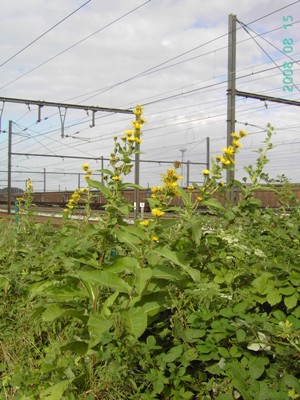Verloove (2008) reported about the discovery in 2001 of a well-established population of Inula racemosa Hook. f., a native of the western Himalayas, by a railway track near Kortrijk (Marke). In the very same area (Rollegem) a second, smaller population was furthermore discovered on an old dump in 2006. This species had long been confused with the exceedingly similar Inula helenium L.
|
|
| Inula helenium |
In the past years it became evident that Inula racemosa is widely overlooked in Belgium, especially in the southern part of West-Vlaanderen but also elsewhere. In the surroundings of Kortrijk it was recorded, for instance, in Harelbeke (De Gavers), Kortrijk-Hoge (waste land), Lauwe (former clay pit), etc. It was furthermore seen along river Schelde near Gavere (at least since 2006), near Haaltert, between Diepenbeek and Hasselt,…. Today Inula racemosa (especially its cv. ‘Sonnenspeer’) is probably more popular in cultivation than I. helenium and more likely to occur as a garden escape. In most of its localities it was recently confirmed and usually appears to be firmly established.
 |
 |
 |
| Inula racemosa | ||
Inula racemosa and I. helenium are surely closely related (see also Verloove 2008) but nevertheless usually easily distinguished. The former has a narrow inflorescence with inflorescence branches rather closely appressed to the stem and with most flowers (nearly) sessile. In Inula helenium, in contrast, the inflorescence is corymbose and much wider with inflorescence branches that are widely divaricate and with most flowers long-stalked. Both are opposed in the following couplet:
- Inflorescence corymbose and wide, most flowers pedunculate. Inflorescence branches long and divaricate === Inula helenium
- Inflorescence racemose and narrow, most flowers sessile. Inflorescence branches closely appressed to the stem === I. racemosa
Reliable photos of Inula racemosa are apparently rare. Original photos of both I. helenium and I. racemosa are here presented and show the rather different jizz of both (see also the excellent line drawings by Sven Bellanger in Verloove l.c.)
However, probably not all problems that surround the Inula helenium-group are resolved. Some plants are less typical (inflorescence narrow but with several flowers long-pedicelled) and possibly represent hybrids between Inula helenium and I. racemosa. Moreover, in addition to the aforementioned species one should also watch out for Inula macrocephala Boiss. et Kotschy ex Boiss. (syn.: I. helenium var. macrocephala (Boiss. et Kotschy) Parsa) and I. magnifica Lipski. Both species have inflorescences with only 2-3(-4) flowers that are ca. 9-15 cm across but otherwise much look like Inula helenium. See Jäger & al. (2008) for more details. At least the latter has been reported as an escape from cultivation in Germany.
References
Jäger E.J., Ebel F., Hanelt P. & Müller G. (eds.) (2008) Rothmaler Band 5. Exkursionsflora von Deutschland. Krautige Zier- und Nutzpflanzen. Springer Verlag, Berlin: 880 p.
Verloove F. (2008) Enkele nieuwe neofyten in België en Noordwest-Frankrijk. Dumortiera 94: 1-8.



Add new comment